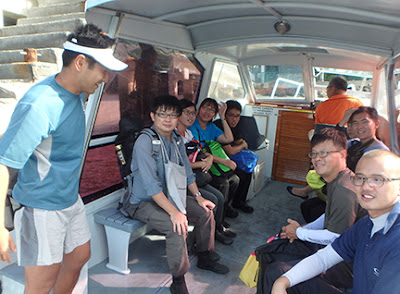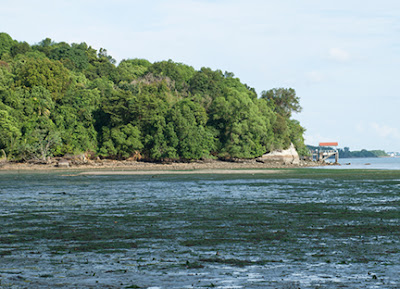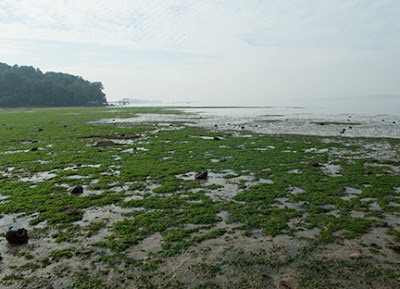Alas, we didn't see any signs of seagrasses on this trip. What has happened here? I looked more closely at my old photos of this shore to see what might have changed.
Thanks to the kind invitation of Alex Tan of OBS, the regular team had a chance to visit this 'mini-Chek Jawa next to their facilities on Pulau Ubin.
Alex had gathered some OBS colleagues who stayed back to explore the sea shore with us. We are touched! Thanks to Marcus Ng, the expert on our island histories, we got an introduction to some of the key historical aspects of Pulau Ubin.
Thanks also to Phillip Lim, who runs a fish farm off Pulau Ubin, for sharing his wisdom about the ecology and creatures to be found in our waters. From crabs to clams, to plankton blooms and more.
The rest of the survey team also helped to set up 'stations' to explain interesting marine life found on this shore. Here is Lisa Lim, sharing about the intriguing snails that laid the egg capsules we saw earlier on our walk.
As we make our way to the sand bar near the mouth of the lagoon, more 'stations' have been prepared.
Here is Loh Kok Sheng sharing about the sand star and rock stars that are found on the shore.
Here's Jonathan sharing about crab moults and other interesting critters. We saw swimming crabs, stone crabs and porcelain crabs. Many tiny hermit crabs and the Blue striped hermit crab. Thanks also to Richard Kuah.
Nicholas Yap had found 'Bill' a yet-to-be-identified large sea anemone. We also saw several Spiral babylonia snails and the black eggs of some kind of sotong. Later on, an octopus was found on the way home!
Where have the seagrasses gone?
I was most dismayed to learn that there are probably zero seagrasses anywhere in the lagoon. We didn't see any growing or even any seagrass bits being washed up on the shore.
There are still many Haddon's carpet anemones on the sand bar at the mouth of the lagoon, but no seagrasses.
The lagoon is instead mostly covered with a thick layer of soft anoxic mud.
Here's a brief pano from the centre of the lagoon.
March 2008
My first trip to this shore was in March 2008, at a not-so-low tide. The tides appear similar as our trip yesterday.
Most the lagoon was still submerged.
A glimpse of the western shore of the lagoon.
The inner lagoon was covered in seagrasses!
We saw a sea horse during that trip!
June 2008
This was my second trip to this shore. The tide was a lot lower and I saw a lagoon full of seagrasses with marine life commonly seen at Chek Jawa. The lower tide exposed seagrasses growing even in the area near OBS. Perhaps the seagrasses are still on this shore but are in deeper water? We do hope to return on a lower spring tide to check up on this.
Another view eastwards of the seagrasses growing on the lower shore.
As we approached the lagoon, a view of the seagrasses towards OBS Camp 2 jetty.
A view of the seagrasses looking westwards towards OBS.
A view of the lagoon towards the east.
A view of the lagoon towards the west.
A view of the lagoon towards the east.
Seagrasses at the sand bar at the mouth of the lagoon.
There were seagrasses all around the sand bar at the mouth of the lagoon.
A view of seagrasses with Haddon's carpet anemones towards OBS Camp 2 jetty.
The rocks had clumps of colourful sponges. We did see some but not a lot of sponges our trip yesterday. But we haven't been seeing sponges on our Northern shores since around 2014.
In the seagrass meadows, there were the usual animals we commonly encounter at Chek Jawa.
There was even a Spearer mantis shrimp.
March 2013
Looking back, I realise the decline was probably already happening during my third visit to this lagoon. I was there for the Mega Marine Survey's mini-expedition with some volunteers so I didn't really pay attention to the shoreline.
But looking at the photos with new eyes, the large Perepat mangrove tree that dominated the western shore in Mar 2013 was no longer there yesterday.
And there didn't seem to be as much erosion on the western shore in March 2013.
There were not much seagrasses during that trip.
What has changed in Jan 2016?
Yesterday, I noticed a great deal of erosion on the western shore of the bay. With large coastal forest trees falling onto the shore.
The erosion extends a fair distance before the shore becomes a sandy slope on what looks like an old prawn-pond bund. Behind the bund there are thick mangroves.
The mangrove trees growing outside the bund are facing severe erosion.
Erosion is a serious problem on Pulau Ubin. Destroying ecosystems that provide important services such as providing good water quality so important for fish farmers (like Phillip Lim), recreational users (like OBS) and nature lovers (like us). It is thus so fitting that we were together on the shore yesterday to learn and share.
Another exciting collaboration of stakeholders for Pulau Ubin's ecosystems is the Restore Ubin Mangroves (R.U.M.) Initiative which hopes to give Mother Nature a hand in planting mangroves back in areas abandoned aquaculture ponds in Pulau Ubin.
Fortunately, the water at Punggol Jetty was no longer black, like it was on 20 Jan 2016. But we are now in a critical time of the year when plankton blooms are likely to occur, killing farmed and wild fishes and affect marine ecosystems. The spring tides help to flush the water, but these ended yesterday. The risk of a plankton bloom will rise until the next spring tides which occur during Lunar New Year.
Things are not quite right in the Johor Strait. I need your help to keep an eye on it.
Dead Fish Alert!
Please help me monitor dead fishes washing up on the Johor Straits. Please let me know if you see large numbers (more than 20) especially of large dead fishes (more than 20cm long) washing up on the northern shores such as Pulau Ubin, Lim Chu Kang, Sungei Buloh, Kranji, Sembawang, Punggol, Pasir Ris, Changi.
Thank you!
Photos by others on this trip
- Marcus Ng on facebook.
- Loh Kok Sheng on facebook and his blog.
- Lisa Lim on facebook.
- Richard Kuah on facebook.
- Jonathan Tan on facebook.







































